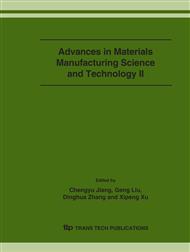p.349
p.353
p.357
p.361
p.365
p.369
p.373
p.377
p.381
Research on the Boring Chatter Suppression Based on MR Fluid
Abstract:
Chatter during boring process is one of the main adverse factors influenced on the machining accuracy of precision hole, surface quality and working efficiency. In order to suppress chatter, an innovative controlling means of MR-intelligent-boring-bar with self-chatter-suppression is proposed, which is composed of MR fluid, shell structure, excitation coil and boring bar. The MR fluid’s mechanical characteristic can be adjusted by changing the intensity of magnetic field, thus the system stiffness and damping will be modified, and then the boring chatter can be suppressed. Otherwise, the dynamic model of MR-intelligent-boring-bar with self-chatter-suppression is built. Lastly, the experimental system of MR-intelligent-boring-bar is established, and the experiments of chatter suppression during boring process are performed. The results of experiments show that the new means of chatter suppression is effective.
Info:
Periodical:
Pages:
365-368
Citation:
Online since:
December 2006
Authors:
Price:
Сopyright:
© 2006 Trans Tech Publications Ltd. All Rights Reserved
Share:
Citation:


